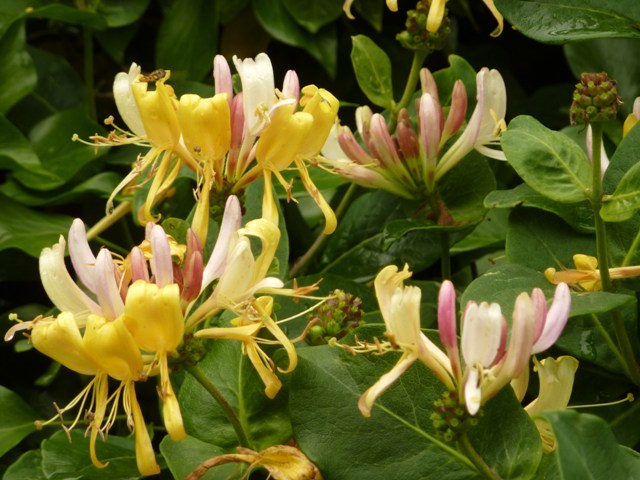
Lonicera or Honeysuckle
There are 5 different species of the climbing and shrubby honeysuckles mentioned in the Wild Flower Key and 11 are mentioned in the Plant Atlas 2020 but only one is native.
Lonicera periclymenum or Common Honeysuckle
A perennial deciduous twining shrub or woody climber, found in woodland, scrub and hedgerows, and on shaded rocks. It prefers freely drained, moderately basic to acidic soils, but also grows on poorly drained base-rich clays.
It is a much loved wild flower as the flowers are highly scented by night, much less so by day. The plant is usually pollinated by moths or long-tongued bees and develops bright red berries.
It was once believed that if honeysuckle grew around a home’s entrance, it would bring good luck and stop any evil spirits from entering. It has also long been considered a symbol of fidelity, and in Victorian times young girls were banned from bringing honeysuckle into the house because it was believed the strong smell would make them have suggestive dreams!
Ornamental and Other Uses:
Lonicera periclymenum is one of several honeysuckle species valued in the garden, for its ability to twine around other plants, or to cover unsightly walls or outbuildings; and for the intense fragrance of its profuse flowers in summer. It needs to be planted with its roots in the shade, and its flowering top in sun or light shade.
Plants need to be chosen with care as they can grow to a substantial size. The cultivars ‘Graham Thomas‘ and ‘Serotina’ have gained the Royal Horticultural Society‘s Award of Garden Merit.
Honeysuckle has been used to make beautiful walking sticks which were once popular with Scots music hall performers. They were created as the honeysuckle entwined itself around branches, causing the branches themselves to become twisted.
While the berries are poisonous, the leaves, flowers and seeds have been used for medicinal purposes for a variety of conditions.
Uses for Wildlife:
Dormice make summer nests for their young from honeysuckle bark; they also eat the flowers, which are a good source of energy-rich nectar. Night-flying moths such as the hummingbird hawk-moth can detect the scent of honeysuckle flowers up to a quarter of a mile away. The clusters of red berries are eaten in the autumn by birds such as thrushes, bullfinches and warblers.
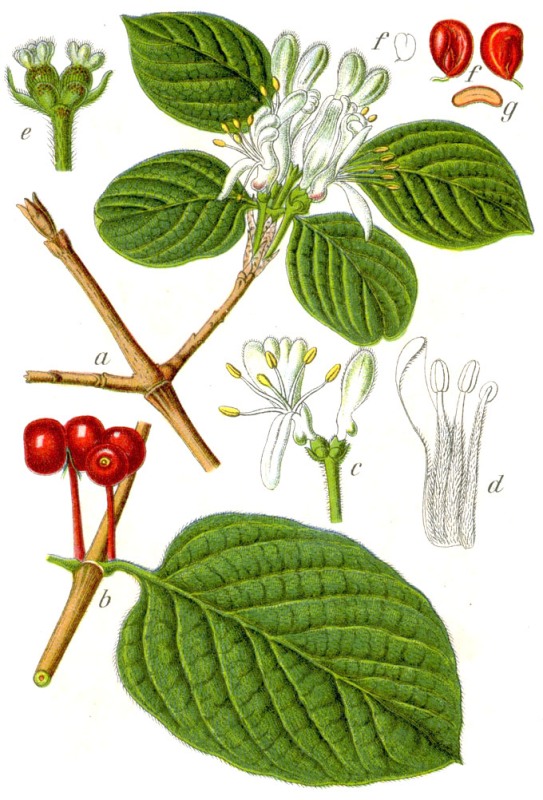
The second common one is probably:
Lonicera xylosteum or Fly Honeysuckle
A deciduous shrub, formerly considered to be native in woodland on chalk in south-eastern England but also widely naturalized on free-draining basic or neutral soils in open woodland, hedgerows and scrub.
L. xylosteum was being cultivated in Britain by 1596. It was first recorded in the wild as a casual in 1770, it has been known from the chalk escarpment of the South Downs near Amberley (West Sussex) since 1801, where it grows in ancient woodland, hedgerows and scrub. Although arguably native there, it is considered to be an introduction given the lateness of its discovery, use as a garden plant and the frequency of introduction elsewhere (Webb, 1985; Pearman, 2007).
This is a dense, bushy, deciduous shrub, to 3m tall, with grey-green foliage. Small, tubular, two-lipped, creamy-white flowers are produced in pairs along the shoots in late spring and early summer, followed by showy red, or rarely yellow, berries
The glossy red (or occasionally yellow) berries of this shrub are mildly poisonous to humans – children who ingest a large number (c. 30) of berries may experience abdominal pain and vomiting.
Other species found on the British Isles are:
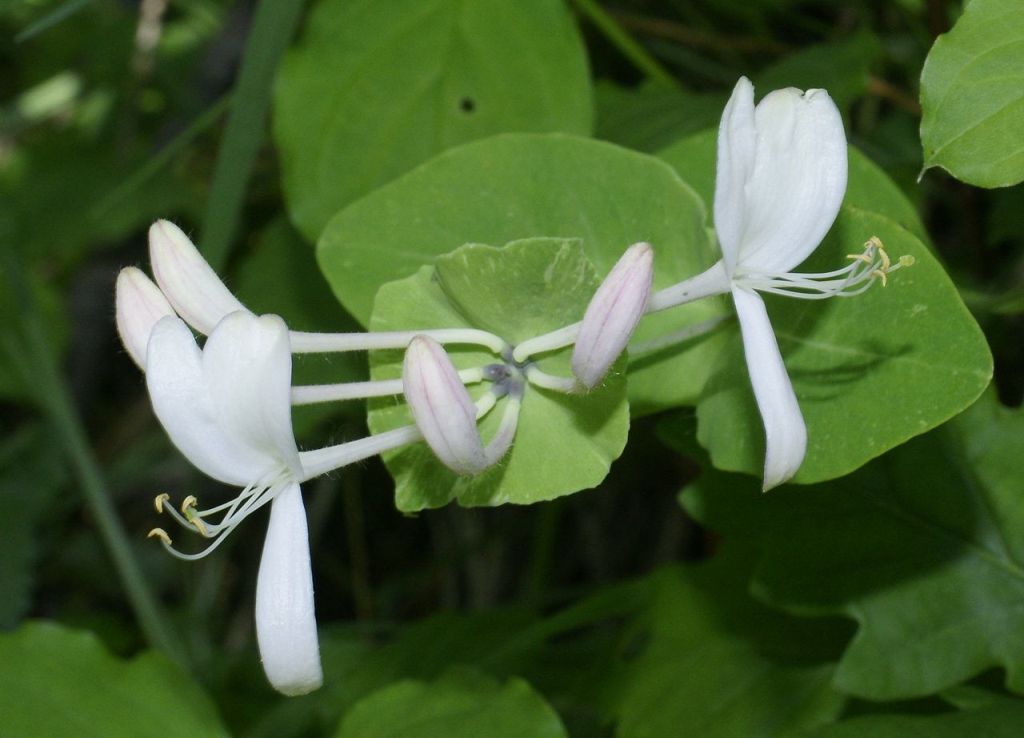
A twining, deciduous climber, naturalized in woodland, scrub and hedgerows, perhaps establishing mainly from bird-sown seed from garden plants
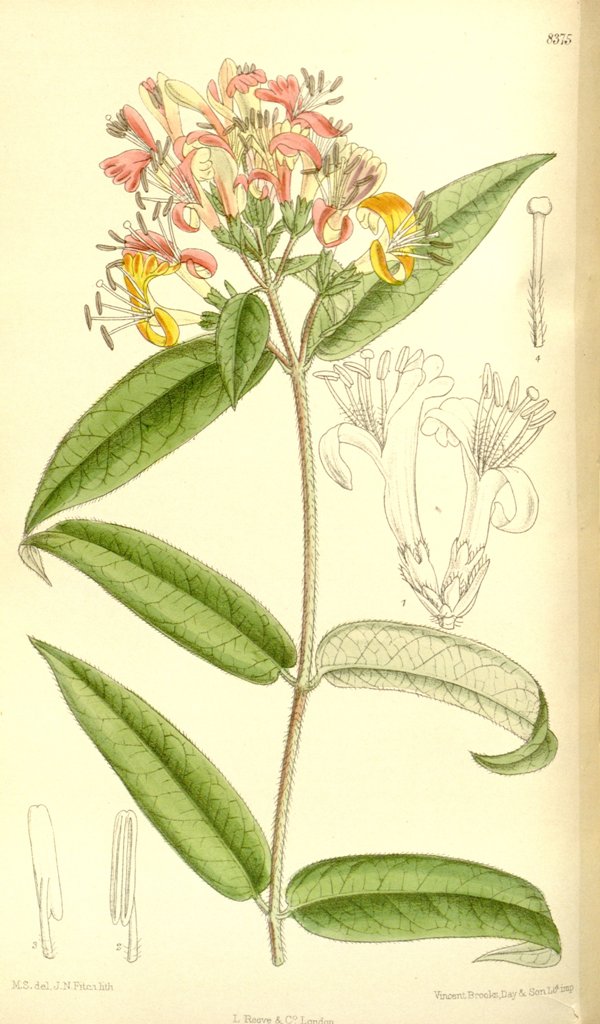
A winter-green or semi-deciduous climbing shrub, naturalized on woodland margins and in hedgerows and rough grassland. It arises as a garden escape or throw-out, and is seldom found far from human habitations. It is also capable of reproducing from seed, which can be bird-sown.
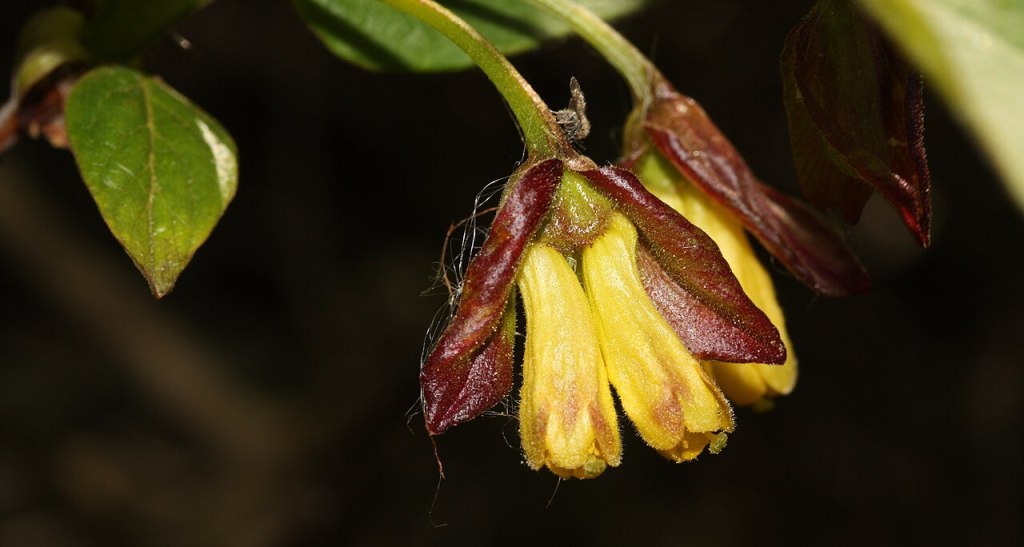
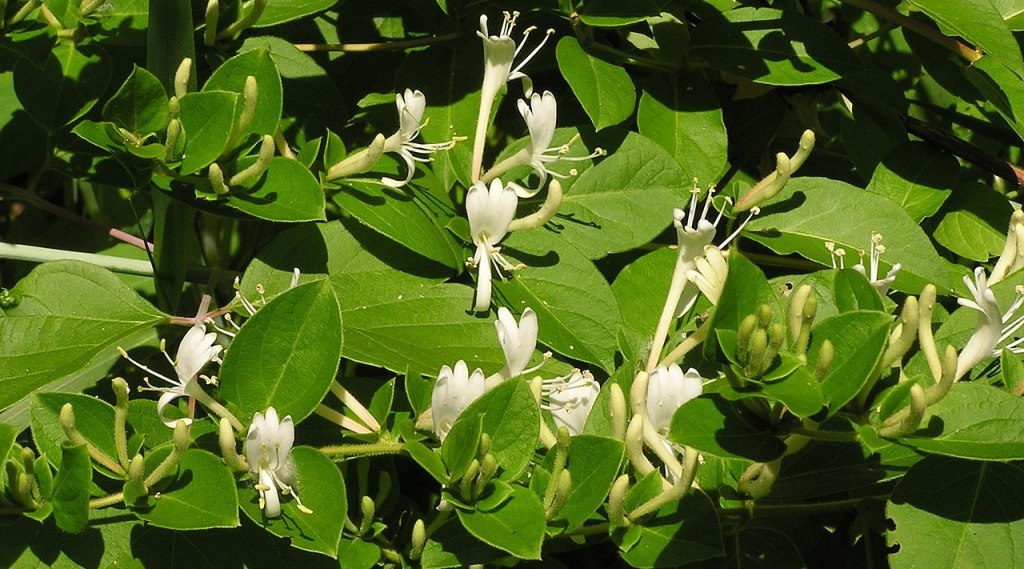
A partially winter-green climbing shrub, widely grown in gardens and frequently spreading to woodland margins, scrub, hedgerows and on waste ground, sometimes forming extensive thickets but seldom far from human habitations. Naturalized plants are often self- or bird-sown, but occasionally originate from dumped garden waste.
Ornamental, Edible and Medicinal Uses:
The cultivars Halliana is well known and I like the cultivar ‘Aureoreticulata’ for its interesting netted foliage! The variety L. japonica var. repens has gained the Royal Horticultural Society‘s Award of Garden Merit.
Japanese honeysuckle flowers are edible to humans and appreciated for their sweet-tasting nectar. The flowers can also be a significant source of food for deer, rabbits, hummingbirds, and other wildlife.
It is an effective groundcover and has strong-smelling flowers.
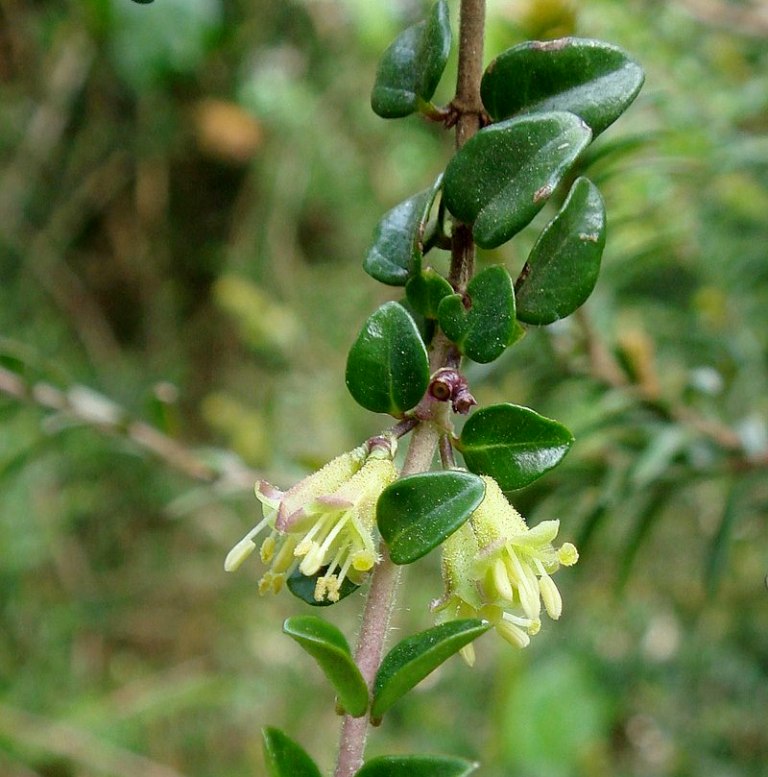
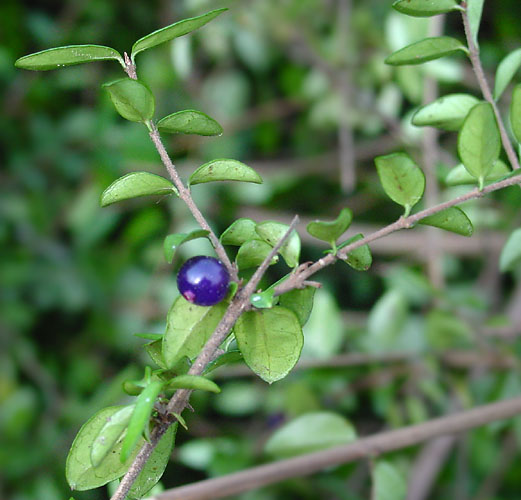
Lonicera nitida or Wilson’s Honeysuckle (flowers & fruit by Wouter Haagens)
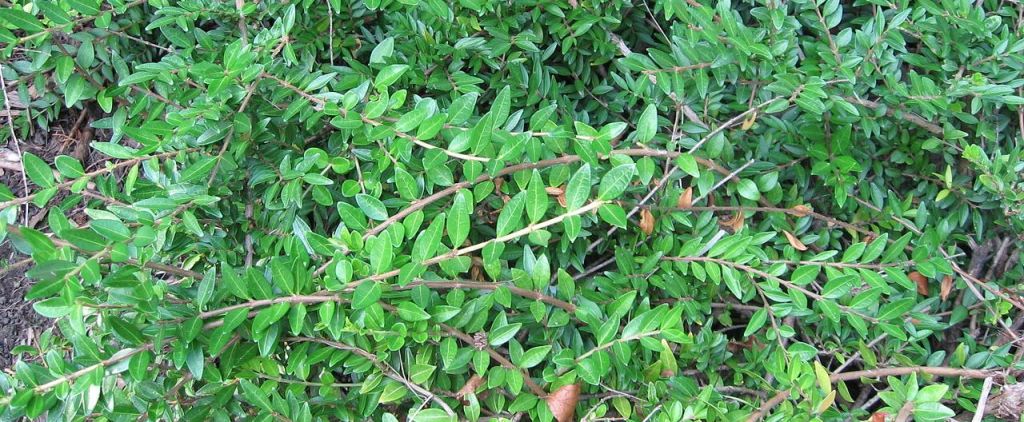
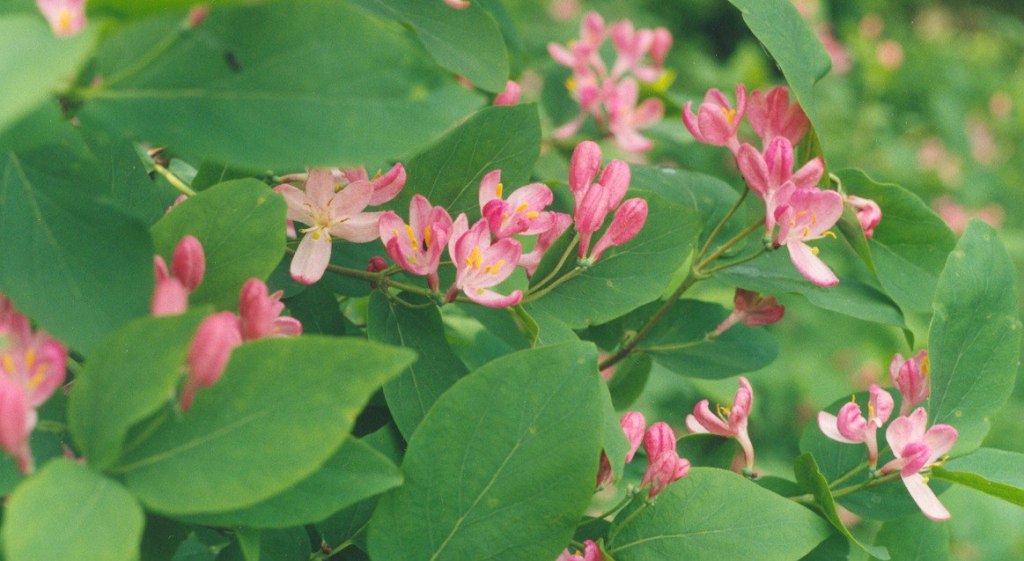
Other genera in Caprifoliaceae
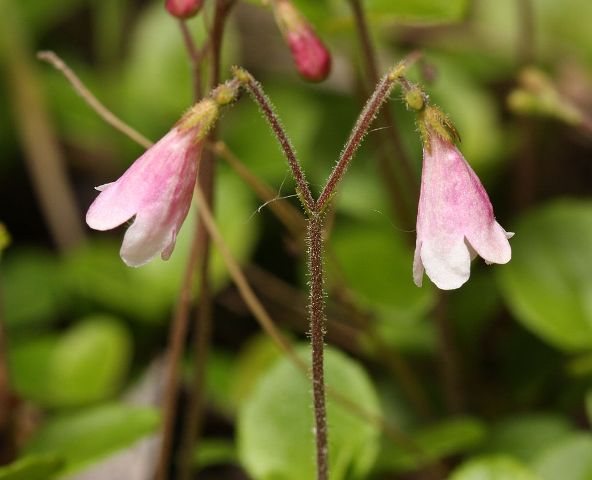
Linnaea borealis or Twinflower
A mat-forming creeping perennial herb of native pinewoods and plantations of Pinus sylvestris, occasionally in birchwoods, and rarely, as a relict of former woodland cover. Populations are fragmented, as a result of loss of pinewood habitat, into a series of (mainly) self-incompatible populations.
The genus Linnaea was first formally described by Carl Linnaeus. The name had been used earlier by the Dutch botanist Jan Frederik Gronovius, and was given in honour of Linnaeus. Linnaeus adopted the name in 1753 inSpecies Plantarum for the then sole species Linnaea borealis, because it was his favourite plant.
L. borealis is a creeping, mat-forming shrub with small, glossy, dark green leaves with buff undersides. In summer pairs of small, pale pink, nodding, bell-shaped flowers are produced from the tips of leafy side shoots. Overall the plant is only 8cm high, but can spread to a metre or more across.
Other non native plants in the Caprifoliaceae
There are several other ornamental escapees on the British Isles in both the honeysuckle genus (Lonicera spp.) as well as different genera.
Two more well known wonderful weedy types below:
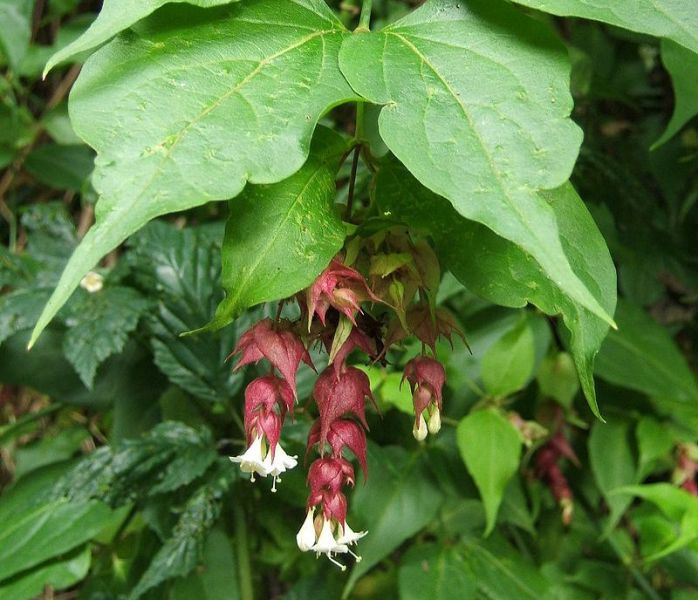
Leycesteria formosa or Himalayan Honeysuckle
A deciduous shrub, widely grown in gardens, and frequently established as a garden escape on walls and at the base of hedgerows, in woodland and shrubberies and on waste ground, mainly in urban areas. Most plants appear to be bird-sown but it is also planted as cover for pheasants.
Uses:
This is a lovely and interesting ornamental which was favoured by the Victorians. It has occasionally escaped into the wild. Also attractive to wildlife for its flowers as well as berries.
Leycesteria formosa, or the Himalayan honeysuckle, Flowering nutmeg, Himalaya nutmeg, granny’s curls or pheasant berry, is a deciduous shrub in the family Caprifoliaceae, native to the Himalaya and southwesternChina. It is considered a noxious invasive species in Australia, New Zealand, the neighbouring islands of Micronesia, and some other places.
From Plants for a Future: One unconfirmed report said that the fruit is edible. In the better forms, the fully ripe and very soft fruit is very sweet with a treacle-like flavour, though in other forms it has a very bitter taste and is not very desirable.
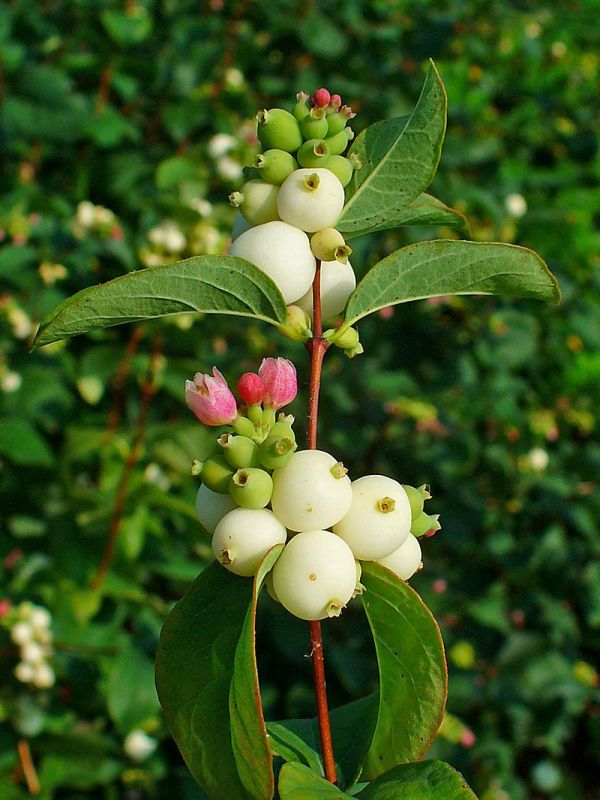
Symphoricarpos albus or Snowberry
A deciduous shrub, spreading by vigorous suckering, widely planted in both gardens and in the wider countryside in hedges and for game cover in woodland. It reproduces by suckering and fruits freely, but regeneration from seed is unknown.
Uses:
It can be excused for its invasive habits as it is a very useful wildlife plant and beautiful en mass with the large, long lasting white berries.
I’ve always noted many bees around the tiny flowers and according to Wikipedia: in North America; many birds and small mammals use it for food and cover. It is sometimes planted as game cover in woods, scrub, etc.
The fruit and shrub itself are poisonous to humans, causing vomiting.
Native Americans used the plant as a medicine and a soap, and sometimes for food, and the wood was good for arrow shafts. In Russia, the berries are crushed in the hands and rubbed about for a soothing folk-remedy hand lotion.
This shrub is used for erosion control in riparian areas, and it is planted in ecological restoration projects on disturbed sites such as abandoned mines.
Symphoricarpos orbiculatus or Coralberry
A deciduous shrub, spreading by suckers which grow to produce dense thickets. It is naturalized in hedges, scrub and on waste ground.
It has got attractive small pink berries, especially nice in winter.
